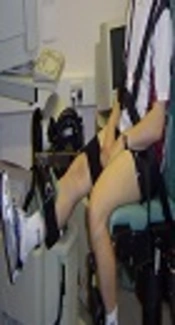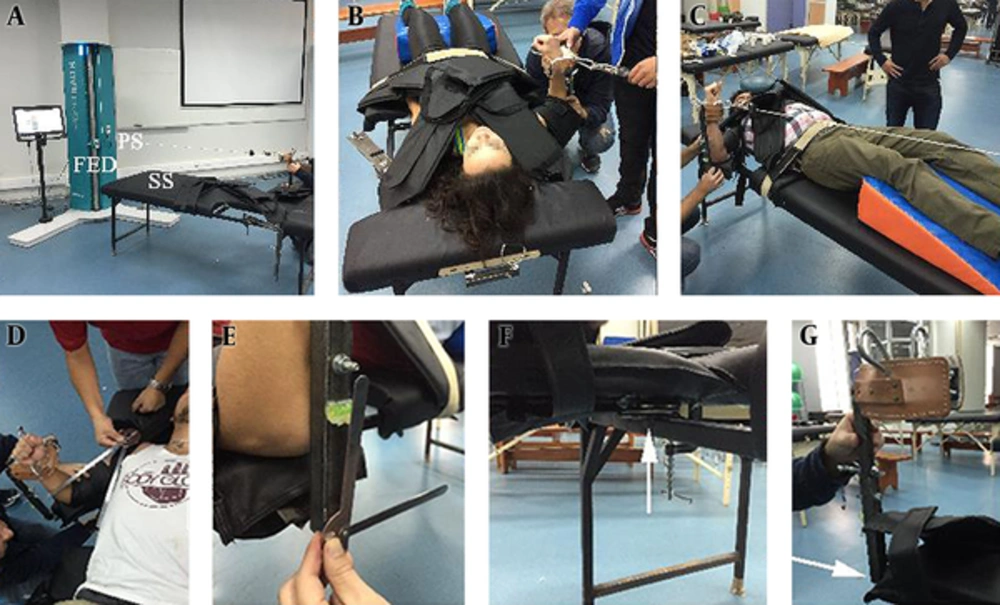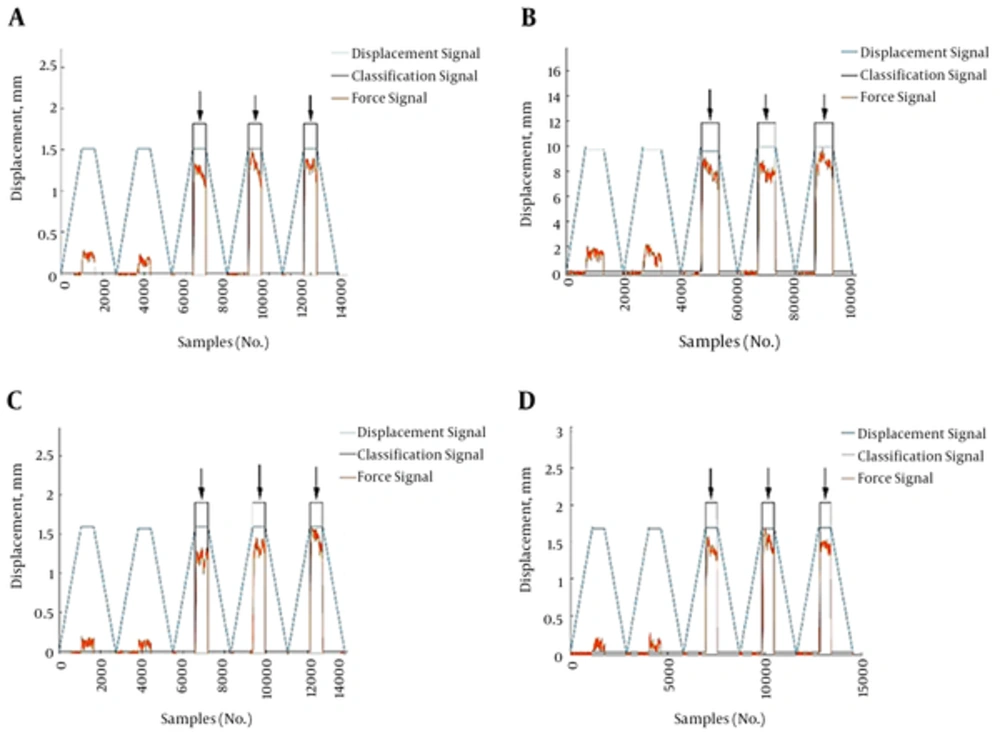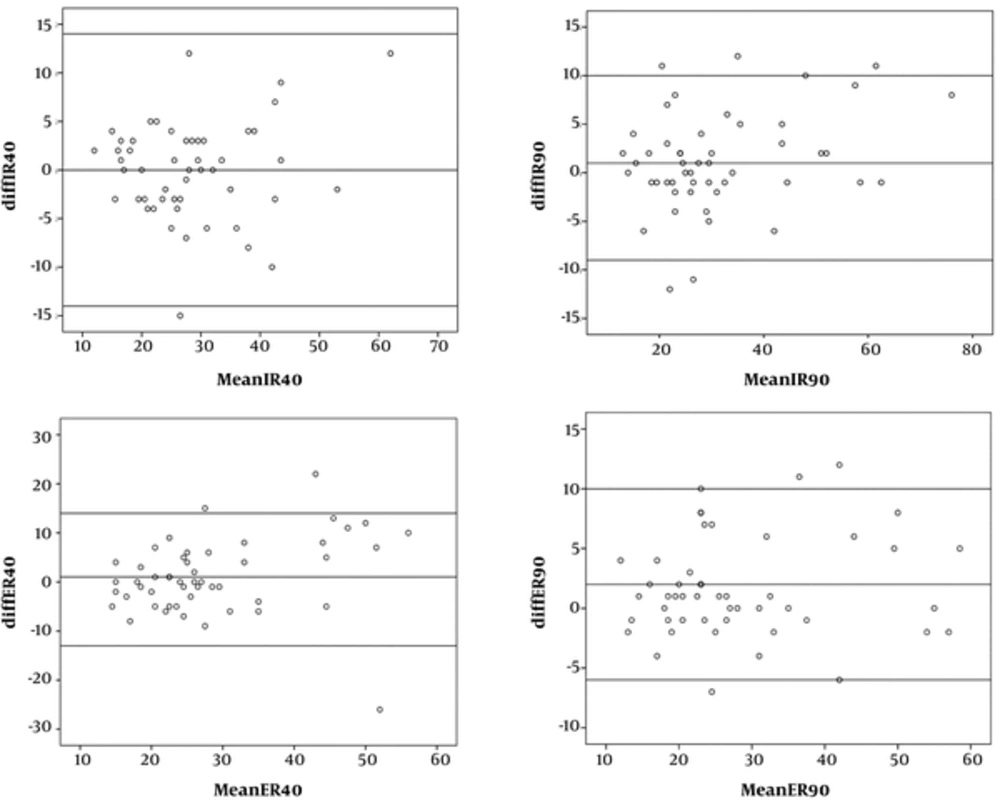1. Background
Muscle strength evaluation of the shoulder internal (IR) and external rotators (ER) is often used by clinicians to assess muscle performance and to guide diagnosis and rehabilitation (1). Dynamometers are commonly used to establish muscle strength and when test-retest is performed, can quantify treatment effectiveness (2, 3). Since these tests must be accurately conducted for adequate decision making, reliability analyses are needed to explore the consistency of measurements performed multiple times under similar conditions (4, 5) and to ensure that changes between measurements are due to differences in performance rather than inconsistencies in the measuring capacity of the applied device (6). Because of its relatively extensive freedom of motion, the shoulder complex offers a great variety of testing positions and articular planes for strength examination (7, 8).
Isokinetic dynamometry (ID) is considered the gold standard for measuring muscle strength (9) mainly because the results are not influenced by a strength imbalance between the participant and the examiner, and a maximal torque can be generated throughout the entire range of motion (10). Indeed, ID provides mechanically valid and reliable measures of torque, position, and velocity for both clinical and research purposes (6). Nevertheless, the elevated costs of this device limit widespread use in clinical practice. Functional electronic dynamometer (FED), which transmits energy from an engine through a cable allowing strength assessments of different body parts (11), could be an alternative in strength assessment. Some advantages of FED compared to ID is its lower cost and the functional strength assessment in addition to analytical assessment permitted by FED. This dynamometer could be a practical and affordable alternative for use in clinical rehabilitation practice and in a research setting. However, the relative and absolute reliability has not been reported in the literature.
2. Objectives
The purpose of the study was i, to determine the relative and absolute reliability of isometric peak torque in shoulder IR and ER using FED in healthy subjects ii, to determine if optimal assessment position of shoulder rotation strength is 40° or 90° of shoulder abduction.
3. Methods
3.1. Design and Setting
This test-retest reliability study was performed at the Human Movement Analysis Laboratory of Pontificia Universidad Catolica de Chile between June and July 2016. Relative and absolute reliabilities were assessed in healthy university students during two sessions, with a 14 day rest-period between sessions. IR and ER isometric peak torques were tested in a supine position with 40° and 90° of shoulder abduction using FED Haefni Health® (Ivolution R and D, Granada, Spain). Test order (i.e. IR and ER) was randomly assigned by a computer program assigned by the Statistician software. A trained rater in this novel device with 4 years of experience was selected.
3.2. Sample and Sampling
A total of 52 asymptomatic non athlete participants (40 females and 12 males; aged 23.3 ± 2.6 years; body mass index 23.2 ± 2.6 kg/m2; SPADI score 4.1 ± 5.7) all with right hand dominance were recruited using advertisement in a local university. Data from 50 participants were analyzed (39 females and 11 males). The Shoulder Pain and Disability Index (SPADI) was developed to measure current shoulder pain and disability in an outpatient setting. SPADI contains 13 items that assess two domains; a 5-item subscale that measures pain and an 8-item subscale that measures disability. A more recent systematic review has found reliability coefficients of ICC ≥ 0.89 in a variety of patient populations. Internal consistency is high with Cronbach α typically exceeding 0.90. Random error of the questionnaire is 18 points. The SPADI demonstrates good construct validity, correlating well with other region-specific shoulder questionnaires. It has been shown to be responsive to change over time, in a variety of patient populations and is able to discriminate adequately between patients with improving and deteriorating conditions (12).
The inclusion criteria were as follows: i, shoulder pain and disability index (SPADI) ≤ 18; and ii, signed informed consent. Exclusion criteria included the following: i, shoulder or neck injury in the last six months; ii, shoulder or neck pain at the moment of the assessment; iii, history of shoulder or neck trauma; iv, history of shoulder or neck surgery; and/or v, orthopedic alterations of the trunk, shoulder, neck, or upper limbs.
3.3. Sample Size Calculation
For simple test- retest experiments without a control group, statistical theory predicts confidence intervals of ± t0.975, n - 1 . s . √2/√n for a change in the mean, where n is the sample size, s is the typical error and t is the t statistic. Equating this expression to the value of the confidence limits representing adequate precision, ±d say, and rearranging:
n = 2 (t . s/d)2 ≈ 8s2/d2
The sample size is proportional to the square of the typical error. Earlier studies (1, 6, 10) have shown SEM values around 25% using an isokinetic dynamometer (ID) for shoulder rotator strength assessment. Assuming that the smallest worthwhile effect (d) is 10%, then the sample size was estimated at 50 participants.
3.4. Codes of Ethics
All participants gave written informed consent prior to participation and were able to withdraw from the study at any time without any consequences. The study was approved in accordance with principles established by the Helsinki declaration by the Scientific ethical committee at the school of Medicine of Pontificia Universidad Catolica de Chile, project No. 16-057, date of approval april 21 2016.
3.5. Novel Instrument
The Haefni Health® is a FED consisting of three primary aspects: mechanical, electronical, and informatics. Mechanically, this system consists of a column to which an adjustable-height pulley system is affixed, thus allowing adaptability for distinct positions, exercises, and attachable devices (Figure 2A). Electronically, the system is equipped with an inextensible cable, a 2.0 Kw linear actuator, and a gauge-strain system attached to a cable that, together with a strength sensor, controls tension, detects force, and relays corresponding signals to the control monitor. Regarding the informatics of the system, the Haefni FED is fully integrated to control and monitor electronical and mechanical aspects, in addition to recording all data, providing web-cam capabilities, and offering 40 linked tables for viewing and interpreting results (11).
Strength testing for shoulder rotators. A, Experimental setup (FED = electromechanical dynamometer, PS = pulley system, and SS = stabilizer system). B, Assessment position. C, Rigid attachment at 90° angle. D, Shoulder goniometry assessment. E, Forearm orientation. F, Proximal joint of the stabilizer system: white arrow shows the joint axis. G, Distal hinge joint of the stabilizer system: white arrow shows joint axis.
3.6. Stabilization System
The custom stabilizer system was anatomically designed and constructed in the human movement analysis laboratory at Pontificia Universidad Catolica de Chile to achieve correct shoulder girdle fixation, to ensure rigid attachment to the dynamometer; and to tolerate the maximal forces and torques generated by participants over 500 tests (50 subjects x 5 contractions x 2 sessions). The system included a steel supported mat table (1.85 m × 0.75 m × 0.70 m (Figure 2A) and an arm support with one degree of freedom at the proximal and distal ends (Figure 2F, G). The arm support permitted projection of the anteroposterior shoulder axis and articulation with the forearm support which was adjustable at each participant’s forearm and rigidly orientated the radial bone attachment to the dynamometer at the wrist (Figure 2E). For adequate participant comfort, the employed stabilizer system and adjustable strands used high density foam covered by synthetic leather.
3.7. Procedures
The measured baseline characteristics of participants included age, height, weight, body mass index, arm length (i.e. forearm length between the olecranon and ulnar styloid processes), and upper-limb dominance (i.e. limb used to throw a ball).
Each participant adopted a supine position. The upper limb was postured as follows: frontal plane at 90° of abduction; elbow flexed at 90° in sagittal plane; and forearm in pronation (Figure 2B, C). The dynamometer was attached to the patient’s wrist by a pulley system, creating a 90° angle between the dynamometer and forearm (Figure 2C). The arm, thorax, and pelvis were fixed with Velcro straps (Figure 2B, C). To further control the anterior translation of the humeral head, another Velcro strap was added. Lower limb comfort was achieved with hip and knee flexion posturing (Figure 2C).
To ensure proper and consistent joint angling between sessions/participants, two senior physical therapists collaborated in joint fixation and in taking shoulder/elbow angle measurements using a stainless steel goniometer (Saehan Corp., South Korea) according Norkin (13) (Figure 2D). To ensure a 90° angle between the dynamometer and patient forearm, a single physical therapist attached the dynamometer using a fluid bar inclinometer when a 90° angle was achieved (Figure 2E).
After achieving proper posturing, the randomly ordered assessments were performed. First, participants were familiarized with the test by performing two submaximal isometric shoulder rotator contractions lasting 6 second(s). Then, three maximal isometric shoulder rotator contractions lasting 6 seconds were performed for the IR and ER at both 40° and 90° (Figure 3). The rest time between strength tests was 1 minute, and the time between contractions was 15 seconds.
Maximal isometric shoulder rotator signal of patient #5. The plots show the four strength tests, with rectangular boxes identifying the maximal contraction signal, trapezoidal boxes identifying the length of the pulley system, and the signal under the trapezoidal and rectangular boxed identifying the force signal. A, IR test at 40°. B, ER test at 40°. C, IR test at 90°. D, ER test at 90°.
3.8. Outcomes
Peak torque: The highest value of the maximal value obtained for each of the three maximal voluntary isometric contractions for the IR and ER at 40° and 90° was selected as dependent variable. The dynamometer recorded force at a sample frequency of 20 Hz, with the obtained units expressed in Newtons. Torque magnitude was calculated from the cross product between the lever arm of the forearm and force of the dynamometer in order to convert the unit of measurement in Newton* meter (Nm). Peak torque was calculated by XX using an automatized algorithm written in the Matlab 2014b software (MathWorks, Inc., USA). The algorithm classified a contraction as isometric if the signal duration of the dynamometer did not present changes or contain signal artefacts. Then, the three maximal muscle contractions were selected while the first two submaximal contractions were discarded (Figure 3). Using the three maximal muscle contractions, the routine evaluated the maximal values extracted from a central, 75% data window to prevent inertial and electrical noise components in the signal force during maximal muscle contraction.
3.9. Data Analysis
IR and ER peak torque at 40° and 90° of shoulder abduction was used for analysis. Data are expressed as the mean ± standard deviation. Normal data distribution was confirmed using the Shapiro-Wilk test. Homogeneity of variance was confirmed using the Bartlett test. One sample Paired t-test was conducted to determine if significant differences existed for the mean measurement between sessions of both internal and external peak torque.
Then, relative reliability was evaluated to determine intra-tester measurement consistence (i.e. level of association between measurements over time). For this, intra tester correlation coefficients (ICC) were used with 95% confidence intervals (CI). ICC was based on a 2- way (random effects) repeated measures analysis of variance model with absolute agreement. ICCs were classified according to Munro (14), where an ICC of 0.0 - 0.25 shows little correlation, of 0.26 - 0.49 shows low correlation, of 0.50 - 0.69 shows moderate correlation, of 0.70 - 0.89 shows high correlation, and of 0.90 - 1.0 shows very high correlation. The level of mean change between measurements was evaluated by Bland-Altman plots. The Bland and Altman analyses also included the graphs in which the difference between test sessions 2 and 1 (test2 minus test1) was plotted against the mean of the two test sessions ((test1 + test2)/2) for each participant and test condition. Absolute reliability was expressed as the standard error of the measurement (SEM). SEM was calculated as SEM = SD/√ 2, where SD is the standard deviation of differences between sessions (13). To produce a unit-free indicator of SEM error magnitude, the results of this analysis were expressed as a percentage of the standard error of measurement (SEM%). SEM% was calculated as SEM*100/mean torque between test 1 and test 2. SEM was used to calculate the minimal detectable change (MDC) at the individual level. The MDC determined the interval that with a 95% of certainty included the random error of the instrument and thus, the smallest amount of change needed to be considered statistically significant. MDC was calculated according to Hopkins (5) as MDC lower limit = difference in peak torque between test 2 and test 1 - (1.96*/√ 2*SEM) for lower limit of agreement and MDC upper limit = difference in peak torque between test 2 and test 1 + (1.96*/√ 2*SEM) for upper limit of agreement. When expressed as percentage of the MDC (MDC%) the calculation was as follows. MDC% lower limit = difference in peak torque between test 2 and test 1 expressed as percentage of peak torque between measurements – (1.96*/√ 2*SEM %) for lower limit of agreement. For upper limit of agreement, MDC % upper limit = difference in peak torque between test 2 and test 1 expressed as percentage of peak torque between measurements + (1.96*/√ 2*SEM %).
All statistical analyses employed a probability of type I error equal to 0.05 and were performed with the SPSS 17.0 statistical software (SPSS Inc., USA).
4. Results
Values presented equal variance for the IR peak torque differences at 40° (P = 0.13); IR at 90° (P = 0.07); ER at 40° (P = 0.91); and ER at 90° (P = 0.36). One sample Paired t test between sessions for IR peak torque at 40° was t = -0.8, P = 0.9; for IR peak torque at 90° t = 1.6, P = 0.1; for ER peak torque at 40° t = 0.9, P = 0.3 and for ER peak torque at 90° t = 2.8, P = 0.07. The relative and absolute reliability results are summarized in Table 1. Bland Altman plots are shown in Figure 4. ICC and CI at 90° were 0.96 (0.94 - 0.98) for IR and 0.94 (0.90 - 0.96) for ER. ICC at 40° were 0.89 (0.80 - 0.94) for IR and 0.97 (0.94 - 0.98) for ER. SEM and SEM% expressed in Nm for IR peak torque at 40° was 3.6 (12.6%); for IR peak torque at 90° 2.8 (8.8%); for ER peak torque at 40° was 5.2 (18.1%) and for ER peak torque at 90° 3.2 (11.4%). MDC expressed in Nm including Bland- Altmann lower and upper limits for peak torque at 90° were -6.5 to 8.9 for IR and -7.8 to 9.8 for ER while for 40° MDC were -10 to 9.9 for IR peak torque and -13.4 to 15.4 for ER. MDC% including Bland- Altmann lower and upper limits for IR peak torque was -20.8, 28.4% for IR at 90°; -28.1, 35.2 for ER at 90°; -35,5%, 34,8%; for IR peak torque at 40° and -46,8%, 53,8% for ER at 40°.
| Variables | Strength Tests | |||
|---|---|---|---|---|
| Internal Rotation, 40° of Abduction | External Rotation, 40° of Abduction | Internal Rotation, 90° of Abduction | External Rotation, 90° of Abduction | |
| Measurement sessions, mean ± SD, Nm | ||||
| Session 1 | 28.4 ± 10.1 | 28.1 ± 10.7 | 30.9 ± 13.6 | 27.5 ± 12.0 |
| Session 2 | 28.3 ± 10.8 | 29.1 ± 12.5 | 32.1 ± 15.2 | 28.5 ± 12.3 |
| Relative reliability | ||||
| ICC | 0.94 | 0.89 | 0.97 | 0.96 |
| 95% ICC | 0.90 to 0.96 | 0.80 to 0.94 | 0.94 to 0.98 | 0.94 to 0.98 |
| Absolute reliability | ||||
| SEM, Nm | 3.6 | 5.2 | 2.8 | 3.2 |
| SEM%, % | 12.6 | 18.1 | 8.8 | 11.4 |
| MDC 95% CI, Nm | -10.0, 9.8 | -13.4, 15.4 | -6.5, 8.9 | -7.8, 9.9 |
| MDC% 95% CI, % | -35.1, 34.8 | -46.8, 53.8 | -20.8, 28.4 | -28.0, 35.2 |
Reliability Results of Novel Electromechanical Dynamometrya
Bland-Altman plots. A, internal rotator peak torque at 40°; B, internal rotator peak torque at 90°; C, external rotator peak torque at 40°. D, External Rotator Peak Torque at 90°. diffIR40 = internal rotation peak torque difference at 40°, diffIR90 = internal rotation peak torque difference, diffER40 = external rotation peak torque difference at 40°, diffER90 = external rotation peak torque difference at 90°, meanIR40 = mean internal rotation peak torque at 40°, meanIR90 = mean internal rotation peak torque at 90°, meanER40 = mean external rotation peak torque at 40°, meanER90 = mean external rotation peak torque at 90°.
5. Discussion
The timely and accurate detection of improvements or deteriorations after a physical intervention requires a reliable, sensitive instrument applicable over time. Based on Munro (14), the obtained intra-rater reliability values rated very high for the IR at 40°, IR at 90°, and ER at 90° and as high for the ER at 40°. Similar high intra-rater reliability values were obtained in prior assessments of ER peak torque at 40°, by Anderson (15) (ICC = 0.75) using a Kin-Com isokinetic dynamometer (Chattecx Corp., USA); by van Meeteren (16) (ICC = 0.87) using a Biodex isokinetic dynamometer (Biodex Medical Systems, Inc., USA); by Kuhlman (17) (ICC = 0.83) using a LIDO isokinetic dynamometer (Cybex, Inc., USA), and by Malerba (18) (ICC = 0.81) using a Biodex isokinetic dynamometer. Only Kramer (19) obtained a very high ICC (0.94) using a Kin-Com isokinetic dynamometer. All assessments were done in seated position except for Kuhlman (17). For ER peak torque assessed at 90°, Hadzic (20) obtained a very high ICC (0.93) using a REV 9000 isokinetic dynamometer (Technogym, Italy). Similar results was reported by Plotnikoff (21) (ICC = 0.90) using a Kin-Com isokinetic dynamometer, but this study assessed average torque instead of peak torque.
For IR peak torque assessed at 40° of arm elevation, very high ICC values were found by Dauty (1) (ICC = 0.94) using a Cybex Norm isokinetic dynamometer (Cybex, Inc., USA) and by Kramer (19) (ICC = 0.94) using a Kin-Com isokinetic dynamometer assessing in seated position. In turn, high reliability values were reported by Anderson (15) (ICC = 0.86) using a Kin-Com isokinetic dynamometer, while moderate reliability was achieved by van Meeteren (16) (ICC = 0.74) using a Biodex isokinetic dynamometer. All assessments were done seated. Finally, for IR strength tests at 90°, the currently presented results are in accordance with Forthomme (22), who used a Cybex Norm isokinetic dynamometer, and Hadzic (20), who used a REV 9000. Based on ICC analysis of this study, IR peak torque assessments can be done at either 40° or 90° of arm elevation, but ER torque assessments have higher relative reliability if performed at 90°.
Lower absolute reliability in peak torque measurements was recorded when isometric rotator strength was performed at 40°. Specifically, SEM % ranged from 12.6 to 18.1% for IR when assessed at 90° and 40° respectively and from 11.4 to 18.1% for the ER. This suggests greater data instability when 40° of shoulder abduction is adopted to assess shoulder rotation. Therefore, we recommend that assessments are performed at 90° to more precisely determine the effects of any particular intervention.
MDC% upper limit was lower for IR (28.4%) and ER (35.2%) assessments at 90° compared to 40°, which produced MDC% of 34.8% and 53.8%, respectively. Translated to a rehabilitation program for ER strengthening, this would mean that differences between pre and post-rehabilitation measurements using FED would have to be 35.2% or 53.8% higher than initial values at 90° or 40°, respectively, to be considered outside the random error. On the other hand, if a shoulder injury occurs, in order to generate a muscular atrophy in ER outside the random error, torque assessment at 40° should decrease in 46% compared to the initial value. Prior cadaveric shoulder rotator experiments showed that ER at 90° of glenohumeral abduction creates instability due to a lack of participation by the biceps brachialis, coracobrachialis, anterior deltoid, major pectoral, and subscapularis, all of which could favor stabilization of the glenohumeral girdle (23). Furthermore, the external rotators are susceptible to major fatigue, which could be a source of variability during strength generation tests (24). Stabilization straps typically increase reliability in strength related studies (25, 26). The electromechanical systems do not have their own stabilization straps. To avoid noise to the measurements that can alter the subject’s performance, the arm, thorax, and pelvis were fixed with Velcro straps. To further control the anterior translation of the humeral head, another Velcro strap was added. Lower limb comfort was achieved with hip and knee flexion posturing. This stabilization system could be a factor in obtaining high to very high concurrent validity, but still external rotators showed lower reliability scores. This suggests that shoulder IR maximal voluntary isometric strength test is more reliable than shoulder external rotators maximal voluntary isometric strength test, but the effect of the stabilization system needs to be studied in future studies with other designs. At 90°, the MDC% for the IR and ER were within reported ranges (21 to 30%) (15, 18) using a REV 9000 isokinetic dynamometer and a Cybex norm isokinetic dynamometer. Specifically, for ER contraction, Anderson (15) obtained a MDC of 55.4% using a Kin-Com isokinetic dynamometer, while Forthomme (22) reported an MDC of 56.2% using a Cybex Norm isokinetic dynamometer in the scapular plane. In turn, IR strength tests have reported MDC% ranging from 20% - 30%, such as in Meeteren (16) when using a Biodex isokinetic dynamometer, as well as Forthomme (22) when using Cybex norm isokinetic dynamometer in the scapular plane.
Although high to very high ICC values were found for all test positions and although MDC% values were similar to those established by other gold-standard isokinetic dynamometers (27), it is important to note that improvements/deteriorations of less than 15% are clinically relevant (5). These differences cannot be detected using either isokinetic devices or the currently tested FED. As with any strength assessment, stabilization system and tester expertise are relevant factors that may result in a lower MDC. In the present study, the tester had 2 years of experience with the FED system and the supine position was adopted to allow better scapular fixation. Despite this, the MDC was higher than the minimal relevant change.
Based on our results, we recommend using 90° of arm elevation for assessing peak torque in the ER since this angle has a higher ICC and lower MDC%. For evaluations of peak torque in the IR, we also recommend using 90° of arm elevation; although ICC values are similar between 40° and 90°, MDC% values are lower using 90°.
Prior to widespread adoption of any strength assessment device, test re-test reliability and concurrent validity of the new system is needed. This work has shown that FED had similar ICC and absolute reliability of results in test re-test design compared to ID in the shoulder joint. Thus, due to lower costs and easy use, it is an alternative dynamometer in analytic strength assessment. Compared to hand held dynamometers, it has the main advantage that peak torque is not influenced by assessor strength. As FED is a functional dynamometer, it may overcome some limitations of ID but test re-test studies should be performed to determine its psychometric properties in different functional strength assessments.
The main limitations of this study were the use of a convenient sample, an unbalanced gender representation among participants, and the young age of the participants. In conclusion, isometric strength testing protocol using FED showed an excellent reproducibility and can be safely used in clinical settings to monitor the strength changes in a group of individuals or in a single individual. Small but clinically relevant changes under 20% are included in the random error of this dynamometer.




